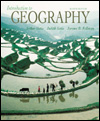 |  Introduction to Geography, 8/e Arthur Getis,
San Diego State University
Judith Getis
Jerome D. Fellmann,
University of Illinois, Urbana-Champaign
Economic Geography
Objectives:After reading and studying this chapter you should be able to:
1.
Define and differentiate among subsistence, commercial and planned economies.
|
 |  |  | 2.
Enumerate the characteristics of intensive and extensive subsistence agriculture.
|
 |  |  | 3.
Define the Green Revolution and list its costs and benefits.
|
 |  |  | 4.
Distinguish between just-in-time and flexible production methods.
|
 |  |  | 5.
Understand von Thunen's model of agricultural land use and the mechanism by which land uses are allocated
to different locations.
|
 |  |  | 6.
Understand the concept of comparative advantage and how it relates to international development.
|
 |  |  | 7.
Distinguish activities as primary, secondary, tertiary and beyond tertiary and classify occupations into each of
the categories.
|
 |  |  | 8.
List the major manufacturing regions of the world and enumerate the locational factors which led to their
importance.
|
 |  |  | 9.
Explain the major locational considerations for industrial production.
|
 |  |  | 10.
Explain the rise of high technology industries and their associated locational considerations.
|
|



 2002 McGraw-Hill Higher Education
2002 McGraw-Hill Higher Education